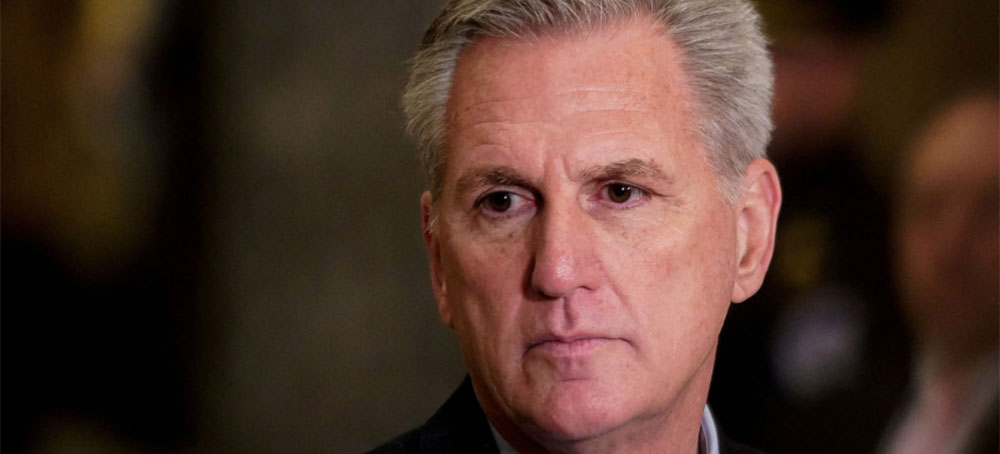
21 January 23
Live on the homepage now!
Reader Supported News
ON FUNDING WE HAVE NO CHOICE, WE MUST ACT — Regardless of how much we or our readers dislike fundraising and we all do, the organization must pay its bills. Either we cease to exist or we figure out to raise the very few dollars we need to address costs. So we do what we must.
Marc Ash • Founder, Reader Supported News
Sure, I'll make a donation!

Neil Young | David Crosby Is Gone, but His Music Lives On
Neil Young, Neil Young Archives
Young writes: "David is gone, but his music lives on. The soul of CSNY, David's voice and energy were at the heart of our band."
David is gone, but his music lives on. The soul of CSNY, David’s voice and energy were at the heart of our band. His great songs stood for what we believed in and it was always fun and exciting when we got to play together. ‘Almost Cut My Hair’ ‘Dejavu’, and so many other great songs he wrote were wonderful to jam on and Stills and I had a blast as he kept us going on and on. His singing with Graham was so memorable, their duo spot a highlight of so many of our shows.
We had so many great times, especially in the early years. Crosby was a very supportive friend in my early life, as we bit off big pieces of our experience together. David was the catalyst of many things.
My heart goes out to Jan and Django, his wife and son. Lots of love to you. Thanks David for your spirit and songs, Love you man. I remember the best times!
READ MORE
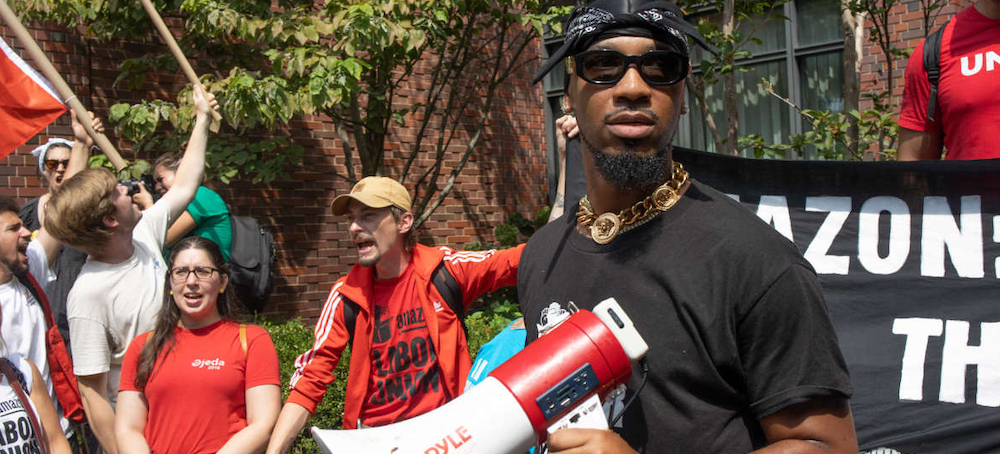 Chris Smalls, a leader of the Amazon Labor Union, leads a march of Starbucks and Amazon workers and their allies to the homes of their CEOs to protest union busting in New York City. (photo: Andrew Lichtenstein/Getty Images)
Chris Smalls, a leader of the Amazon Labor Union, leads a march of Starbucks and Amazon workers and their allies to the homes of their CEOs to protest union busting in New York City. (photo: Andrew Lichtenstein/Getty Images)
If America Had Fair Laws, 60 Million Workers Would Join a Union Tomorrow
Luke Savage, Jacobin
Savage writes: "According to the latest data, the ranks of unionized workers grew by 200,000 between 2021 and 2022. If the United States' unionization rules in place weren't so biased toward bosses, tens of millions more workers indicate they would have joined a union, too."
According to the latest data, the ranks of unionized workers grew by 200,000 between 2021 and 2022. If the United States’ unionization rules in place weren’t so biased toward bosses, tens of millions more workers indicate they would have joined a union, too.
According to data newly published by the Bureau of Labor Statistics and the National Labor Relations Board, the number of American workers belonging to unions rose over the past year. Amid the general trajectory of decline that has defined the last several decades of American labor organizing, the total number of unionized workers across the country rose by roughly 200,000 — with especially large increases visible in Alabama (40,000), Maryland (40,000), Ohio (52,000), Texas (72,000), and California (99,000). Between October 2021 and September 2022, the number of petitions to the National Labor Relations Board for union elections jumped by an astonishing 53 percent.
Driving the increase was a wave of unionization among workers of color, 231,000 more of whom now belong to unions (the number of white workers belonging to unions actually decreasing by 31,000). While 88,000 of new union jobs were added in the public sector, successful organizing in industries like entertainment, transport, and warehousing added 112,000 new union jobs in the private sector.
But in their analysis of the data, researchers at the Economic Policy Institute (EPI) explain why the new data, taken as a whole, are less than encouraging. For one thing, the economy added nonunion jobs at a greater rate than unionized ones, so the overall share of workers with union membership actually declined very slightly from 11.6 percent to 11.3 percent. Also, the raw numbers, though not insubstantial, were driven in part by unusually strong job growth that won’t necessarily persist into the coming years. Still, seen in relation to other developments such as the fifty-year high in public support for unions registered by Gallup in 2021, the data offers some evidence that a nascent fightback against the long-term decline of unionized work has begun.
But perhaps the most remarkable statistic highlighted in the EPI’s analysis concerns the number of workers who wanted to join a union in 2022 but couldn’t: some 60 million, or 48 percent of the entire nonunion workforce. It’s ironic, given the political right’s frequent justification of anti-union laws under the auspices of choice and voluntarism (evident in Orwellian phrases like “right to work”) that the appetite for union membership is so much higher than current union density would suggest. As the EPI’s researchers also pointedly note, “the large increase in the share of workers expressing a desire for unionization over the last four decades has occurred at the same time the share of workers represented by a union has declined.”
This divergence is owed, in significant part, to employer-friendly laws and regulations that make it incredibly difficult to organize a workplace even when a majority of workers might be in favor. A recent study by University of Oregon labor scholar Gordon Lafer, for example, finds that the climate facing workers at many companies effectively resembles that faced by democratic opposition movements during sham elections in one-party dictatorships. For one, existing laws governing unionization are almost comically slanted toward employers. Furthermore, when management does break the rules — employers are charged with violating federal law in more than 40 percent of union elections — penalties are often so lax that they can be treated as little more than the cost of doing business: a state of affairs that allows for rampant intimidation and election-rigging. As Lafer illustrates, using several examples from the auto industry:
[At Tesla] the Labor Board recently concluded that the company committed a series of violations, including illegally firing one union supporter and disciplining another because of their union activity; threatening employees with a loss of stock options if they joined a union; restricting employees from speaking with the media; coercively interrogating union supporters; and barring employees from distributing union information to their co-workers. So too, the CEO at Fuyao Glass — the country’s largest producer of automobile glass — was filmed openly reporting to the firm’s chairman that he had fired employees who tried to organize a union.
The decades-long decline of unionized labor, as the EPI’s analysis concludes, has thus not occurred because workers don’t want to join unions, but rather because the design of current labor law is prohibitive to forming them even when the appetite for doing so is strong. Through determination, grit, and courage, and with the winds of unusually strong job growth at their backs, hundreds of thousands of workers across America successfully joined unions last year. With more democratic labor laws in place, tens of millions more would eagerly have done the same.
READ MORE
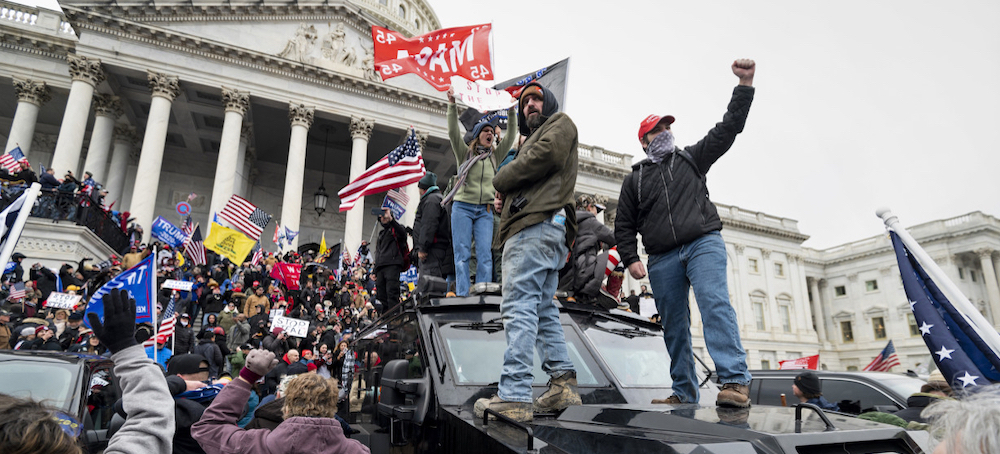 Trump supporters stand on a Capitol Police armored vehicle as others take over the steps of the Capitol, Jan. 6, 2021. (photo: Bill Clark/CQ-Roll Call/Getty Images)
Trump supporters stand on a Capitol Police armored vehicle as others take over the steps of the Capitol, Jan. 6, 2021. (photo: Bill Clark/CQ-Roll Call/Getty Images)
Three Active-Duty Marines Are Charged in the January 6 Riot
Associated Press
Excerpt: "A Marine who said he was waiting for 'Civil war 2' and two other active-duty members of the military have been charged with participating in the riot at the U.S. Capitol, authorities said in newly filed court papers."
AMarine who said he was waiting for "Civil war 2" and two other active-duty members of the military have been charged with participating in the riot at the U.S. Capitol, authorities said in newly filed court papers.
Micah Coomer, Joshua Abate and Dodge Dale Hellonen were arrested this week on misdemeanor charges after their fellow Marines helped investigators identify them in footage among the pro-Trump mob on Jan. 6, 2021, according to court papers.
Dozens of people charged in the riot have military backgrounds, but these three are among only a handful on active duty. A Marine Corps officer seen on camera scuffling with police and helping other members of the mob force their way into the Capitol was charged in 2021.
No defense lawyers for the men were listed in the court docket, so it was not immediately clear whether they have attorneys to comment on their behalf.
Their service records show they are all active-duty Marines. Maj. Kevin Stephensen, a spokesman for the Marine Corps, said it is aware of the allegations and "is fully cooperating with appropriate authorities in support of the investigation."
Coomer, of Indiana, is stationed in Southern California's Camp Pendleton; Abate, of Virginia, is at Fort Meade in Maryland; and Hellonen, of Michigan, is stationed at North Carolina's Camp Lejeune, according to the Marines.
The men spent about 52 minutes inside the Capitol, authorities say. At one point while in the rotunda, they put a red "Make American Great Again" hat on a statue to take pictures with it, according to court papers. Hellonen was carrying a "Don't Tread on Me" flag, authorities said.
Coomer posted photos on Instagram that appeared to be taken inside the Capitol with the caption "Glad to be apart of history," according to court documents. Days after the 2020 election, he and another person discussed over Instagram message how he believed the election was rigged.
And in late January 2021, he told another person in a message that "everything in this country is corrupt."
"We honestly need a fresh restart. I'm waiting for the boogaloo," Coomer wrote in a message detailed in court documents. When asked by the person what's "a boogaloo," Coomer responded "Civil war 2," authorities said.
The boogaloo is an anti-government, pro-gun extremist movement. Its name is a reference to a slang term for a sequel — in this case, a second U.S. civil war. The movement is named after "Breakin' 2: Electric Boogaloo," a 1984 sequel to a movie about breakdancing.
Supporters have shown up at protests over COVID-19 lockdown orders and protests over racial injustice, carrying rifles and wearing tactical gear over Hawaiian shirts. The shirts are a reference to "big luau," a riff on the term "boogaloo" sometimes favored by group members.
During an interview related to his security clearance in June, Abate acknowledged walking through the Capitol with two "buddies," investigators said. Abate said they "walked around and tried not to get hit with tear gas."
The Pentagon said Abate was assigned to the Marine Cryptologic Support Battalion, which supports the National Security Agency. One of the largest U.S. intelligence agencies, the NSA spies on electronic communications around the world and has a critical role in deterring cyberattacks and foreign influence operations.
A spokesperson for the NSA declined to answer questions about when the agency learned of Abate's statement that he had entered the Capitol or if it took action prior to his arrest to restrict his access to classified information.
The trio face charges including illegal entry and disorderly conduct.
Among Jan. 6 defendants with military backgrounds are members of the far-right extremist group the Oath Keepers, accused of plotting to violently keep President Donald Trump in power. The group's leader, Stewart Rhodes, a former Army paratrooper, was convicted of seditious conspiracy in November.
A Navy reservist from Virginia accused of storming the Capitol was convicted this week on charges that he illegally possessed silencers disguised to look like innocuous cleaning supplies. Hatchet Speed is scheduled to go on trial in his Jan. 6 case later this year.
And a former U.S. Army reservist described by prosecutors as a Nazi sympathizer was convicted of storming the Capitol to obstruct Congress from certifying President Joe Biden's electoral victory. Timothy Hale-Cusanelli, who was employed as a security contractor at a Navy base, was sentenced to four years in prison in September.
Nearly 1,000 people have been charged so far in the riot and the tally increases by the week. Almost 500 people have pleaded guilty to riot-related charges and more than three dozen have been convicted at trial.
READ MORE
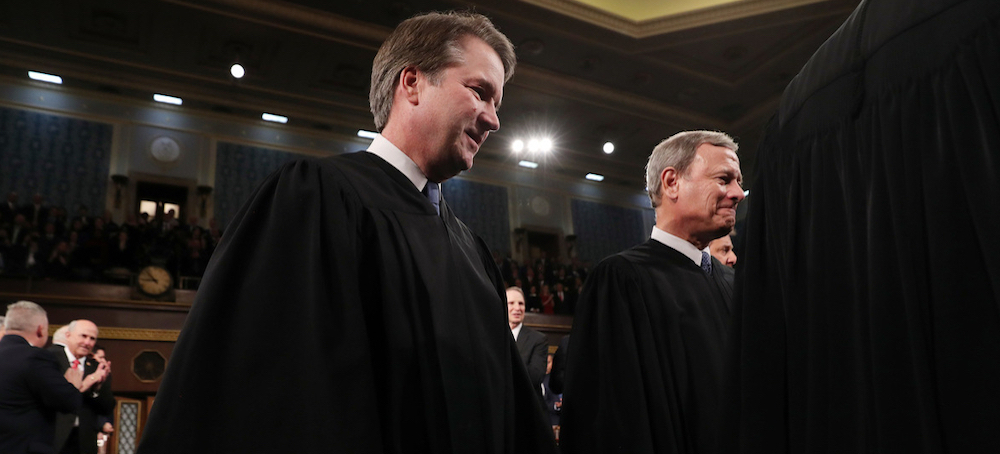 Justice Brett Kavanaugh and Chief Justice John Roberts. (photo: Getty Images)
Justice Brett Kavanaugh and Chief Justice John Roberts. (photo: Getty Images)
New Brett Kavanaugh Sexual Assault Allegations Revealed in Secret Sundance Doc
Nick Schager, The Daily Beast
Schager writes: "Brett Kavanaugh's 2018 confirmation to the Supreme Court was embroiled in controversy when multiple women accused him of sexual assault. One of them, Christine Blasey Ford, testified before Congress about the alleged attempted rape she suffered at his hands in high school."
A surprise, last-minute addition to the Sundance lineup, the rage-inducing film “Justice” features new on-the-record allegations of Kavanaugh assaulting women at Yale.
Brett Kavanaugh’s 2018 confirmation to the Supreme Court was embroiled in controversy when multiple women accused him of sexual assault. One of them, Christine Blasey Ford, testified before Congress about the alleged attempted rape she suffered at his hands in high school. Justice is a horrifying and infuriating inquiry into those claims, told in large part by friends of Ford, lawyers and medical experts, and another of Kavanaugh’s alleged victims: Deborah Ramirez, a classmate of his at Yale.
Most damning of all, it features a never-heard-before audio recording made by one of Kavanaugh’s Yale colleagues—Partnership for Public Service president and CEO Max Stier—that not only corroborates Ramirez’s charges, but suggests that Kavanaugh violated another unnamed woman as well.
A last-minute addition to this year’s Sundance Film Festival, Justice is the first feature documentary helmed by Doug Liman, a director best known for Hollywood hits like Swingers, Go, The Bourne Identity, and Edge of Tomorrow. His latest is far removed from those fictional mainstream efforts, caustically censuring Kavanaugh and the political process that elevated him to the nation’s highest judicial bench, and casting a sympathetic eye on Ford, Ramirez ,and their fellow accusers.
Liman’s film may not deliver many new bombshells, but he and writer/producer Amy Herdy makes up for a relative dearth of explosive revelations by lucidly recounting this ugly chapter in recent American history, as well as by giving voice to women whose allegations were picked apart, mocked and, ultimately, ignored.
The biggest eye-opener in Justice comes more than midway through its compact and efficient 85-minute runtime, when Liman receives a tip that leads him to an anonymous individual who provides a tape made by Stier shortly after the FBI—compelled by Ford’s courageous and heartrending testimony before the Senate Judiciary Committee—briefly reopened its investigation into embattled then-nominee Kavanaugh.
In it, Stier relays that he lived in the same Yale dorm as Kavanaugh and, one evening, wound up in a room where he saw a severely inebriated Kavanaugh with his pants down, at which point a group of rowdy soccer players forced a drunk female freshman to hold Kavanaugh’s penis. Stier states that he knows this tale “first-hand,” and that the young woman in question did not subsequently remember the incident, nor did she want to come forward after she’d seen the vile treatment that Ford and Ramirez were subjected to by the public, the media, and the government. The Daily Beast has reached out to Justice Kavanaugh for comment about the fresh allegations.
Stier goes on to explain that, though he didn’t know Ramirez, he had heard from classmates about her separate, eerily similar encounter with Kavanaugh, which she personally describes in Justice. According to Ramirez, an intoxicated Kavanaugh exposed himself right in front of her face in college, and that she suppressed memories of certain aspects of this trauma until she was contacted by The New Yorker’s Ronan Farrow.
As Ramirez narrates in a trembling tone that seems on the perpetual verge of cracking, she suffered this indignity quietly, convinced that she was to blame for it (because she too was under the influence) and humiliated by the guffaws of the other men in the room. Her account is convincing in its specificity, and moving in its anguish.
Ramirez confesses that some of Farrow’s questions made her worried that she still wasn’t recalling everything about that fateful night, and it’s Stier’s recording that appears to fill in a crucial blank. Stier says he was told that, after Kavanaugh stuck his naked member in Ramirez’s face, he went to the bathroom and was egged on by classmates to make himself erect; once he’d succeeded in that task, he returned to harass Ramirez some more.
It's an additional bit of nastiness in a story drowning in grotesqueness, and Liman lays it all out with the sort of no-nonsense clarity that only amplifies one’s shock, revulsion and dismay—emotions that go hand-in-hand with outrage, which is stoked by the numerous clips of Kavanaugh refuting these accusations with unconvincing fury and falsehoods.
Through juxtapositions of Kavanaugh’s on-the-record statements and various pieces of evidence, Justice reveals the many lies advanced by the judge in order to both sway public opinion and to give Republicans enough reasonable-doubt cover to vote in favor of his confirmation.
Moreover, in a lengthy segment about text conversations between Kavanaugh’s college buddies and Ramirez’s Yale classmate Kerry Berchem, the film persuasively suggests that Kavanaugh and his team were aware of Ford and Ramirez’s charges before they became public, and sought to preemptively counter them by planting alternate-narrative seeds with friends and acquaintances.
While Liman relies a bit too heavily on graphical text to convey some of this, the idea that Kavanaugh (or those closest to him) conspired to keep his apparent crimes secret—along with his general reputation as a boozing party-hard menace—nonetheless comes through loud and clear.
Surprisingly, although Ford is seen speaking to Liman just off-camera at the beginning of Justice, she otherwise doesn’t appear except in archival footage. Still, her presence is ubiquitous throughout the documentary, which generates further anger by noting that the FBI ignored Stier’s tip, along with the majority of the 4,500 others they received regarding Kavanaugh. The Bureau instead chose to send along any “relevant” reports to the very Trump-administration White House that was committed to getting their nominee approved.
The effect is to paint the entire affair as a charade and a rigged game in which accusatory women were unfairly and maliciously put on the defensive, and powerful men were allowed to skate by on suspect evasions and flimsy denials.
Justice is more of a stinging, straightforward recap than a formally daring non-fiction work, but its direct approach allows its speakers to make their case with precision and passion. Of that group, Ramirez proves the memorable standout, her commentary as thorough and consistent as it is distressed.
In her remarks about Kavanaugh’s laughter as he perpetrated his misconduct—chortling that Ford also mentions to Congress—she provides an unforgettable detail that encapsulates the arrogant, entitled cruelty of her abuser, as well as the unjust system that saw fit to place him on the nation’s highest legal pedestal.
READ MORE
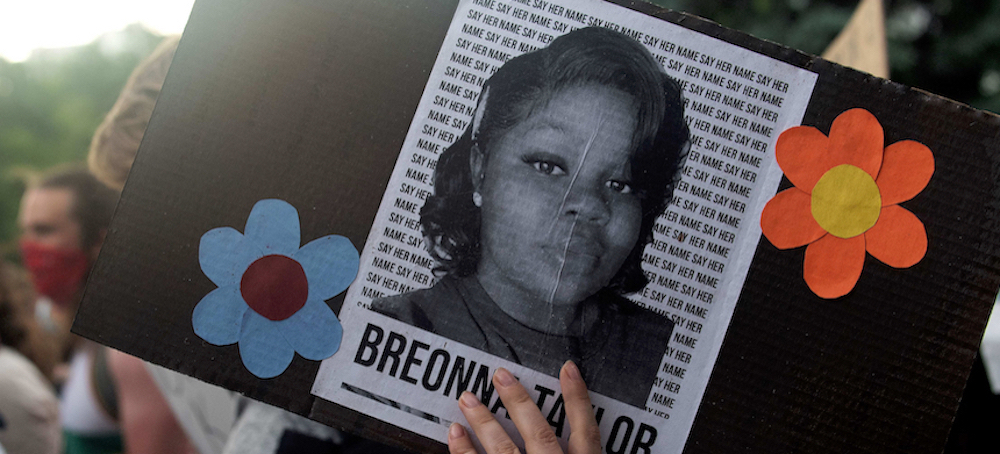 A demonstrator holds a sign with the image of Breonna Taylor. (photo: Jason Connolly/AFP/Getty Images)
A demonstrator holds a sign with the image of Breonna Taylor. (photo: Jason Connolly/AFP/Getty Images)
Kentucky GOP Club Blares Footage of Breonna Taylor's Death to People Innocently Eating Their Dinner
Prem Thakker, The New Republic
Thakker writes: "The Republican Women's Club of South Central Kentucky held an event with one of the cops in the raid that killed Breonna Taylor. Diners unaffiliated with the event heard and saw graphic descriptions of her death as they ate."
The Republican Women's Club of South Central Kentucky held an event with one of the cops in the raid that killed Breonna Taylor. Diners unaffiliated with the event heard and saw graphic descriptions of the raid as they ate.
The Republican Women’s Club of South Central Kentucky held an event this week honoring one of the cops in the raid that killed Breonna Taylor.
The event took place on Tuesday at Anna’s Greek Restaurant, a well-known local restaurant in Bowling Green, with a dining area and second-floor space where events can be held. There, former Louisville Metro Police Department Sergeant Jonathan Mattingly, one of the officers who conducted the no-knock warrant and raid that killed Taylor in March 2020, reportedly shared photos and blared video footage with gunshot noises.
Meanwhile, the restaurant was open to the public at the time of the event. Guests, some of whom had made reservations, were not informed by management about the last-minute event happening upstairs. Guests, including people of color, there for their own dinner plans were then shocked by what appeared to be a bustling event celebrating an officer who was part of the raid that killed a Black woman in her own home.
Cayce Johnson, a guest at the restaurant that night, told The New Republic that the lights dimmed in the middle of their meal. “The woman comes back on and introduces Jonathan Mattingly, and everyone just roared upstairs—applause, cheers, and our mouths just dropped.” Sound carried throughout Anna’s, a retro-fitted old church.
Johnson said Mattingly took the audience “back to March 2020” before going through the presentation with photos and video footage with the sound of gunshots. “One of the members of our group was a war veteran and he has PTSD, so we were just in extreme shock.”
Katelyn Jones, another diner, told TNR the event also included a raffle and jokes about Covid-19. She said the event was initially so loud her father couldn’t hear anything at the table.
After realizing the event included Mattingly, Johnson and her friends sought out the restaurant owner, Vilson Qehaja. Qehaja responded to the group’s concerns by literally shrugging his shoulders, according to video footage. “I have no idea what’s happening, so,” he said as the group complained about the presentation on Taylor. “I have nothing to do with that, so.”
One of Johnson’s friends said “Do you realize who that is? They killed somebody, a cop. He’s a cop…I made reservations, I came from Kansas City.”
“You’re being served, right?” Qehaja responded.
Guests say Qehaja later simply turned up the music.
“He was drinking his coffee and staring at us raising his eyebrows, kind of intimidating us, like, ‘What are you going to do?’” Johnson said. Qehaja’s behavior mimicked what event attendees upstairs allegedly were doing, as guests claimed men from the audience glared down from the second-floor balcony at restaurant-goers, seeming to warn them not to disrupt their event.
An estimated 80 people reportedly attended the event.
Since the event, Mattingly has left a glowing review of Anna’s—and gotten into fights with people who say his presence disrupted their dinner. He did not explicitly deny reports of gunshot noises during the presentation.
“It is beyond reprehensible to subject anyone, let alone children and customers of African American descent, to such indecent exposure, graphic and upsetting images while they were attempting to enjoy their meal,” said the Bowling Green-Warren County Branch of the NAACP in a statement. “Such disturbing occurrences must not be tolerated especially in places of public accommodation. At a minimum, these acts are devoid of humanity and violate the most fundamental principles of human decency.”
TNR reached out to the Louisville Metropolitan Police Department. They had no comment.
The event took place despite earlier controversy about Mattingly’s presence. He was originally slated to appear alongside Agriculture Commissioner and Kentucky gubernatorial candidate Ryan Quarles at the Bowling Green Country Club. In a post from their now-removed Facebook page, the Republican Women’s Club said Mattingly was going to “share what really happened during the raid that killed Breonna Taylor, what he saw, and how the media’s narrative has been corrupted and twisted to fit into a false, woke storyline.” After the event garnered attention from the media and local political leaders, Quarles and the Bowling Green Country Club both backed out.
Attempts were also made to contact the Republican Women’s Club of South Central Kentucky and its officers, to no avail. Regina Webb, a Republican who ran for the state House of Representatives in 2012, claimed ignorance about the event to TNR. Webb, listed by the secretary of state in 2020 as vice president and director of the women’s Republican club, also said she was not involved in the club.
“A lot of people attending are actually people in positions of power in Bowling Green… People are hesitant to put their name out there for fear of retribution,” Johnson said. “They thought that because they were going to secretly and quietly move the event, there would be no one who knew what it was, and no one to call them out.”
“We are calling them out.”
READ MORE
 Deforestation near Humaita, in Amazonas state, Brazil. (photo: Bruno Kelly/Reuters)
Deforestation near Humaita, in Amazonas state, Brazil. (photo: Bruno Kelly/Reuters)
Brazil Begins First Operations to Protect Amazon
Agence France-Presse
Excerpt: "Brazil this week began the first operations against Amazon deforestation since veteran leftist Luiz Inacio Lula da Silva took office, the Ibama environmental agency said Friday."
Brazil this week began the first operations against Amazon deforestation since veteran leftist Luiz Inacio Lula da Silva took office, the Ibama environmental agency said Friday.
On the campaign trail before his October election victory -- when he defeated far right climate change skeptic Jair Bolsonaro -- Lula promised to end deforestation by 2030.
The Amazon rainforest suffered during Bolsonaro's four-year presidency as the former army captain repeatedly enacted laws favoring agriculture and mining in the forest at the expense of that critically important ecosystem. Reducing deforestation is key to slowing climate change.
"The deployment of teams for the start of inspection operations began on January 16, 2023," Ibama told AFP.
Average Amazon deforestation soared by 75 percent during Bolsonaro's presidency, compared with the previous decade.
"The environmental team put in place by the federal government has, since the beginning of the transition period, been working to build a plan capable of inverting the rate of deforestation seen these last few months," added Ibama.
On Wednesday, Lula told the Globo News television channel that he wanted to create a federal police force to "act in a stronger manner" to protect forests.
He also said he wanted to arrange a meeting with the other South American countries that share the Amazon to discuss a continental preservation policy.
Lula said he would fight deforestation "by any means" and added: "I will need the armed forces, I will need the federal police force."
Since taking office on January 1, Lula has signed a series of decrees pertaining to the protection of the Amazon.
He also reactivated an Amazon protection fund that had been frozen since 2019 due to a disagreement between the Bolsonaro government and major donor countries Norway and Germany over how to spend the money.
And Lula revoked a Bolsonaro decree authorizing mining exploitation in Indigenous areas and protected zones.
READ MORE
 Center of a storm: Red-billed queleas terrified a herd of elephants as they stopped at a watering hole at the Satao Camp water hole in East Tsavo, Kenya. (photo: Antero Topp/Caters)
Center of a storm: Red-billed queleas terrified a herd of elephants as they stopped at a watering hole at the Satao Camp water hole in East Tsavo, Kenya. (photo: Antero Topp/Caters)
Kenya Declares War on Millions of Birds After They Raid Crops
Peter Muiruri, Guardian UK
Muiruri writes: "A drive by the Kenyan government to kill up to 6 million red-billed quelea birds that have invaded farms will have unintended consequences for raptors and other wild species, experts have warned."
Toxic pesticides used to eradicate grain-eating quelea may harm the country’s endangered raptors, say conservationists
Adrive by the Kenyan government to kill up to 6 million red-billed quelea birds that have invaded farms will have unintended consequences for raptors and other wild species, experts have warned.
The continuing drought in the Horn of Africa has reduced the amount of native grass, whose seeds are queleas’ main food source, causing the birds to increasingly invade grain fields, putting 2,000 acres (800 hectares) of rice under threat. About 300 acres of rice fields have been destroyed by the birds.
A single quelea can eat up to 10 grams of grain a day, according to the Food and Agricultural Organization (FAO). Farmers in western Kenya stand to lose close to 60 tonnes of grain to the birds. In 2021, the FAO estimated crop losses attributable to the birds amounted to $50m (£40m) annually.
The spraying of fenthion, an organophosphate pesticide, has been the method of choice in fighting the pests in Africa, but the chemical has been described by researchers as “toxic to humans and to other non-target organisms”.
“Fenthion can therefore injure or kill indiscriminately, with consequent adverse effects on non-target organisms,” the reasearchers concluded.
Paul Gacheru, species and sites manager at Nature Kenya, a local affiliate to BirdLife International, said the method used to control quelea should be well-informed since “widespread use of non-target species avicides can result in environmental contamination and mass deaths of other birds and animals”.
“Often, there is poor post-spraying site management, thus increasing the risk of poison-related wildlife deaths, especially among scavenging animals – hence the need to enhance education and awareness on quelea control,” he said.
With an estimated breeding population in Africa of 1.5 billion birds, ornithologists say there are neither enough birds of prey to wipe out vast quelea colonies nor effective, environmentally friendly solutions.
Simon Thomsett, a director at Kenya Bird of Prey Trust, said the culture of guaranteeing human food security above all else would be amplified “due to what we now perceive to be a probability, owing to climate change, as open grasslands that were quelea feeding grounds quickly turn into farmlands”.
In wheat-growing parts of Kenya, Thomsett added, farmers have sprayed any species of birds deemed to be a threat to farms, “yet some of the birds are there to feed on insects that feed on their wheat”.
But it is the effect the pesticide may have on the few remaining raptors that worries him most. “Those on the raptor conservation side of the fence are greatly alarmed at the spraying. Today, all raptors [in Kenya] are endangered. In any case, how effective has the spraying been in the last 60 to 70 years?”
The FAO and the United Nations Environment Programme jointly administer the Rotterdam convention, whose aims include reducing risks from hazardous chemicals in agriculture. They have been considering listing fenthion in Annex III of the treaty, a list of pesticides and industrial chemicals banned or severely restricted on environmental or health grounds.
A report prepared by Robert A Cheke from the University of Greenwich and which was used as a working document in a 2017 FAO workshop in Sudan recommended alternatives to the use of the chemical, including a forecast and control planning method.
“If the efficiency of control operations could be improved, then the quantities of fenthion used could be reduced. One way of improving the efficiency of control strategies is to detect the presence of suitable quelea breeding areas by satellite imagery … or to forecast where the birds are likely to breed,” the report said.
It added: “Given that the birds’ migrations and breeding opportunities are determined by patterns of rainfall, it is possible to devise forecasting systems to predict where the birds are likely to breed and, thus, to concentrate activities in search of the colonies to areas where the birds are likely to be.”
Quelea invasion frequently occurs in many African countries. Six months ago, the FAO released $500,000 to the government of Tanzania to support pesticide spraying, surveillance and capacity-building after 21 million quelea invaded rice, sorghum, millet and wheat fields.
READ MORE
Contribute to RSN
Follow us on facebook and twitter!
Update My Monthly Donation
PO Box 2043 / Citrus Heights, CA 95611



